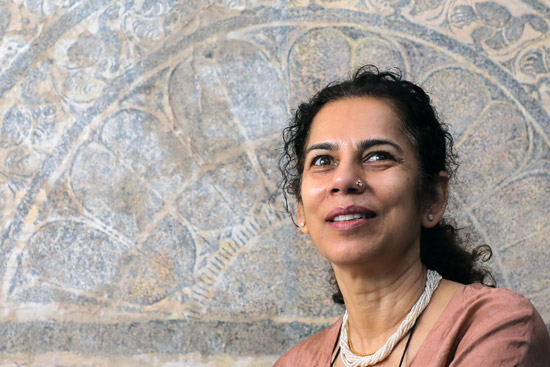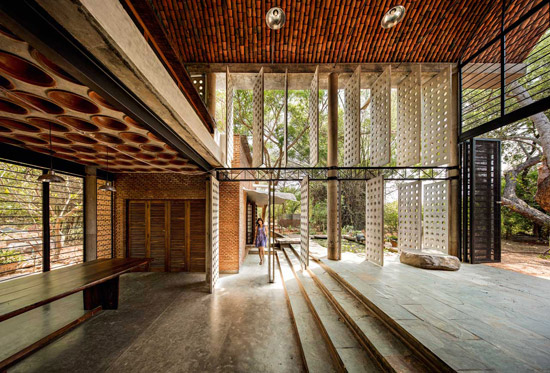Taking time to seek and explore
Anupama Kundoo began the Geoffrey Bawa memorial lecture, telling the audience gathered at the SLFI auditorium that Friday evening how much she enjoyed staying in Bawa’s Colombo residence off Bagatalle Road and how she felt moved to share some common ground.
“Living there and noticing just the life that is at the centre of his work, I’m going to share a little bit of my own journey and where I find common ground….how architects in diverse contexts and in different periods of time are somehow seeking the same thing about creating spaces that enable life to be as soothing as possible for humans; not only the way spaces work for everyday life but also in the processes that are behind how architecture is built and created,” she said.

Anupama Kundoo at the Bawa House. Pic by M.A. Pushpa Kumara
The next morning, speaking to us just before she was due to meet with students, she echoed how much being able to enjoy that space that Bawa himself had created means to her.
That is Anupama Kundoo. She takes time, very consciously, to be in the present.
Regarded as one of India’s most influential woman architects, major awards have come her way but they were never in her master plan. Awarded the 2021 RIBA Charles Jencks award for her contribution to architectural theory and coincidentally, on the same day the Auguste Perret Prize for architectural technology 2021, hers has been a very individual if unconventional journey. That same year, she also received the 2021 Building Sense Now global award of the German Sustainable Building Council, gratifying recognition of her dedicated work and research.

Wall House, Auroville
Contrary to perception, she says she is by nature, a very rooted person. As a fresh graduate from Mumbai’s Sir JJ School of Architecture, certain difficulties led her to leave home and travel through India on her motorbike, settling in Auroville in Tamil Nadu, the city founded in 1968 by Mirra Alfassa, better known as ‘The Mother’, as an experimental community to promote harmony and sustainable living. Just 23, Anupama set up her practice there, working and learning from the local builders, immersing herself in their traditional knowledge and practices.
It was a period of finding herself. She built herself a hut of casuarina wood (normally used only in scaffolding) with a thatched roof and was content living a solitary life. “Many people told me that I was wasting my youth but I just felt every minute was meaningful for me. I was just exploring. I was very passionate as an architect – I was fascinated with the human ingenuity,” she says, looking back. The time she spent in ‘Hut in Petit Ferme’ helped her to learn the value of time and the importance of liberating one’s time.
I always wondered ‘what is the point in doing efficiently things that need not be done at all’ she asks. “Being so efficient that you don’t have time to think.”
Her Bawa lecture is titled “Rethinking Material Resources alongside Human Resourcefulness” and she speaks of how she consciously began to teach herself the things she felt architecture school had not given her, questioning the concepts learned and the ground realities she faced – over-standardization, over-mechanization, losing touch with materials, the labelling of what is vernacular, what is modern, the increasing dependence on consultants. Thus for her it was a conscious choice to stay away from projects, jobs that would curtail her creativity, where she would not be able to ask inconvenient questions and she is deeply grateful that there were always people willing to work with her on her unconventional ideas. “I believe in being true to your calling and it will attract the right people – sometimes also negative experiences but you learn.”
Architecture, she sees, as a backdrop in front of which good life can happen; life-centric, people-centric.
She cites the step wells in India, comparing how their ancestors built when compared to today’s solution – water tanks. “They could have dug a hole. But it’s everybody’s space, there’s a geometry, there’s order; it’s a place that encourages chance encounters – to come there, sit down, forget about the problems of your day.
“Spaces have the power to make us feel alive. Some places make us feel stagnant, some make us feel nourished, they are soothing.”
The narrative of the West that we are poor countries, that is not our narrative when we grew up, she says at the lecture. “I have always looked at the problem of materiality as an opportunity to celebrate human ingenuity. I was fascinated with the human ingenuity,” she says ….. the human potential to do better. “As much as the natural resources are finite, human resources are infinite,” she reiterates.
There are three things she chooses to focus her energy on or tries to nourish in others: “I think the most important potential we have is our imagination – the human capacity to experiment and try out new things; to adapt, to be resilient and to be optimistic.”
Her early projects, saw her fully immersed in her laboratory ‘in her mind’ and she made the site her laboratory, experimenting all the while with different materials, site specific materials and what building for sustainable living in the future required. Five or six years on, her projects were being noticed, there were articles in the local press. Auroville also attracted a stream of visitors and she often found herself taking them around, enjoying the interaction. There came too collaborations with the renowned French architect Roger Anger who produced the Auroville master plan – on many urban and community projects in Auroville.
An invitation to speak at an international conference on women architects in India organised by Brinda Somayer also brought growing recognition of her work.
The Wall House (much featured and acclaimed) the second home she built in Auroville some ten years after her first, showcased many of her innovative ideas drawn from traditional practices; pre-industrial achakal bricks and lime mortar, terracotta roofing systems. This she recreated as a full-scale model at the Venice Biennale in 2012, working with a diverse team of students from Australia and Venice, even stone masons from India to show the common ground between the two cultures – Italian and Indian.
Writing extensively about her research and experiments in new materiality, interesting teaching offers flowed in and would take her to New York (Parsons School of Design), Brisbane (the University of Queensland) and Madrid (the Universidad Camilo José Cela). In 2020, she went to Yale as the Davenport Visiting Professor. “Life took me to places where I got to meet and know a lot of many accomplished architects,” she says adding that it was not driven by any ambition. “I know very well what I have accomplished; I also know what I’m struggling with; I also know my irrelevance in the world…..I’m at home with the irrelevance and yet I know the difference I can make.”
‘Taking Time’, her solo exhibition at the Louisiana Museum of Modern Art, Denmark in 2021 was a retrospective of 30 years of architectural thought and innovation.
Her architectural practice continues in India – in Pune and Pondicherry and in all her sites you will see students and all sorts of materials she says for she believes in letting students experience all the stages of architecture. The computer is useful but not more so than our embodied knowledge and thinking hands and a lot of discoveries are accidental because you were just playing around, she believes.
Her PhD was at Berlin’s Technische Universität and in her role as a Professor of Architecture there now, she has the opportunity to create a Department called ‘Making Matters’. Her aim is to help students go deeper into how things are made, translating their vision into reality, to think of the concepts, the processes and the implications – the whole complexity of architecture’s intersections, from urbanism to health and well-being to economy, as well as the human values that drive their actions.
The prospect is exciting for someone who never envisioned herself as an academic, but finds great fulfilment in nourishing the potential in young people. Education, for her, is not about learning a technical subject, it is about finding your culture, your calling, cultivating your eye, your hands. “There are a lot of discouraging voices in society and it’s not good to always conform to everything in the name of respect. No need to clip your wings. If you realise your full potential, if you nourish your individuality, you are bound to enrich your community.”
“I believe that all of us deserve better circumstances but I don’t think it will be given on a platter,” she says. “We only have to pave the way on which we want to walk. If you don’t like the way things are – and you have a voice inside you saying – you want to go there but there is not a road yet – while walking, pave the way for it.”
The analogy of life’s journey as an ever-flowing river or a spreading tree is one she likes: she’s happy going with the flow or branching out, course correcting when needed. “It doesn’t matter which decision you make, it matters that you try to make the decision right.”
Berlin is where Anupama now makes her home with her two teenagers, a son and a daughter, and she loves the enriching balance of family life and work. Her parents too at some point moved to live with her in her Wall House in Auroville and she notes again how architecture could be that soothing beautiful backdrop to all the challenges we face in our journey of life.
Searching for an ideal partner? Find your soul mate on Hitad.lk, Sri Lanka's favourite marriage proposals page. With Hitad.lk matrimonial advertisements you have access to thousands of ads from potential suitors who are looking for someone just like you.


